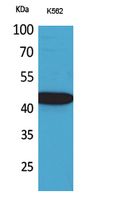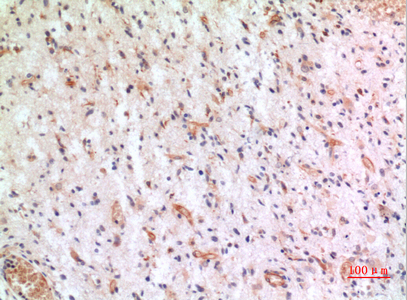Fractalkine Polyclonal Antibody
- Catalog No.:YT5354
- Applications:WB;IHC;IF;ELISA
- Reactivity:Human;Rat;Mouse;
- Target:
- Fractalkine
- Fields:
- >>Cytokine-cytokine receptor interaction;>>Viral protein interaction with cytokine and cytokine receptor;>>Chemokine signaling pathway;>>TNF signaling pathway;>>Human cytomegalovirus infection
- Gene Name:
- CX3CL1
- Protein Name:
- Fractalkine
- Human Gene Id:
- 6376
- Human Swiss Prot No:
- P78423
- Mouse Swiss Prot No:
- O35188
- Immunogen:
- The antiserum was produced against synthesized peptide derived from the Internal region of human CX3CL1. AA range:231-280
- Specificity:
- Fractalkine Polyclonal Antibody detects endogenous levels of Fractalkine protein.
- Formulation:
- Liquid in PBS containing 50% glycerol, 0.5% BSA and 0.02% sodium azide.
- Source:
- Polyclonal, Rabbit,IgG
- Dilution:
- WB 1:500 - 1:2000. IHC: 1:100-1:300. ELISA: 1:20000.. IF 1:50-200
- Purification:
- The antibody was affinity-purified from rabbit antiserum by affinity-chromatography using epitope-specific immunogen.
- Concentration:
- 1 mg/ml
- Storage Stability:
- -15°C to -25°C/1 year(Do not lower than -25°C)
- Other Name:
- CX3CL1;FKN;NTT;SCYD1;A-152E5.2;Fractalkine;C-X3-C motif chemokine 1;CX3C membrane-anchored chemokine;Neurotactin;Small-inducible cytokine D1
- Observed Band(KD):
- 42kD
- Background:
- function:The soluble form is chemotactic for T-cells and monocytes, but not for neutrophils. The membrane-bound form promotes adhesion of those leukocytes to endothelial cells. May play a role in regulating leukocyte adhesion and migration processes at the endothelium. Binds to CX3CR1.,induction:By TNF and IL-1 in pulmonary endothelial cells and umbilical vein endothelial cells.,online information:CX3CL1 entry,PTM:A soluble short 95 kDa form may be released by proteolytic cleavage from the long membrane-anchored form.,similarity:Belongs to the intercrine delta family.,subunit:Monomer.,tissue specificity:Small intestine, colon, testis, prostate, heart, brain, lung, skeletal muscle, kidney and pancreas.,
- Function:
- function:The soluble form is chemotactic for T-cells and monocytes, but not for neutrophils. The membrane-bound form promotes adhesion of those leukocytes to endothelial cells. May play a role in regulating leukocyte adhesion and migration processes at the endothelium. Binds to CX3CR1.,induction:By TNF and IL-1 in pulmonary endothelial cells and umbilical vein endothelial cells.,online information:CX3CL1 entry,PTM:A soluble short 95 kDa form may be released by proteolytic cleavage from the long membrane-anchored form.,similarity:Belongs to the intercrine delta family.,subunit:Monomer.,tissue specificity:Small intestine, colon, testis, prostate, heart, brain, lung, skeletal muscle, kidney and pancreas.,
- Subcellular Location:
- Cell membrane ; Single-pass type I membrane protein .; [Processed fractalkine]: Secreted .
- Expression:
- Expressed in the seminal plasma, endometrial fluid and follicular fluid (at protein level). Small intestine, colon, testis, prostate, heart, brain, lung, skeletal muscle, kidney and pancreas. Most abundant in the brain and heart.
- June 19-2018
- WESTERN IMMUNOBLOTTING PROTOCOL
- June 19-2018
- IMMUNOHISTOCHEMISTRY-PARAFFIN PROTOCOL
- June 19-2018
- IMMUNOFLUORESCENCE PROTOCOL
- September 08-2020
- FLOW-CYTOMEYRT-PROTOCOL
- May 20-2022
- Cell-Based ELISA│解您多样本WB检测之困扰
- July 13-2018
- CELL-BASED-ELISA-PROTOCOL-FOR-ACETYL-PROTEIN
- July 13-2018
- CELL-BASED-ELISA-PROTOCOL-FOR-PHOSPHO-PROTEIN
- July 13-2018
- Antibody-FAQs
- Products Images

- Western Blot analysis of K562 cells using Fractalkine Polyclonal Antibody. Secondary antibody(catalog#:RS0002) was diluted at 1:20000

- Immunohistochemical analysis of paraffin-embedded human-brain, antibody was diluted at 1:100

- Western blot analysis of lysate from K562 cells, using CX3CL1 Antibody.



